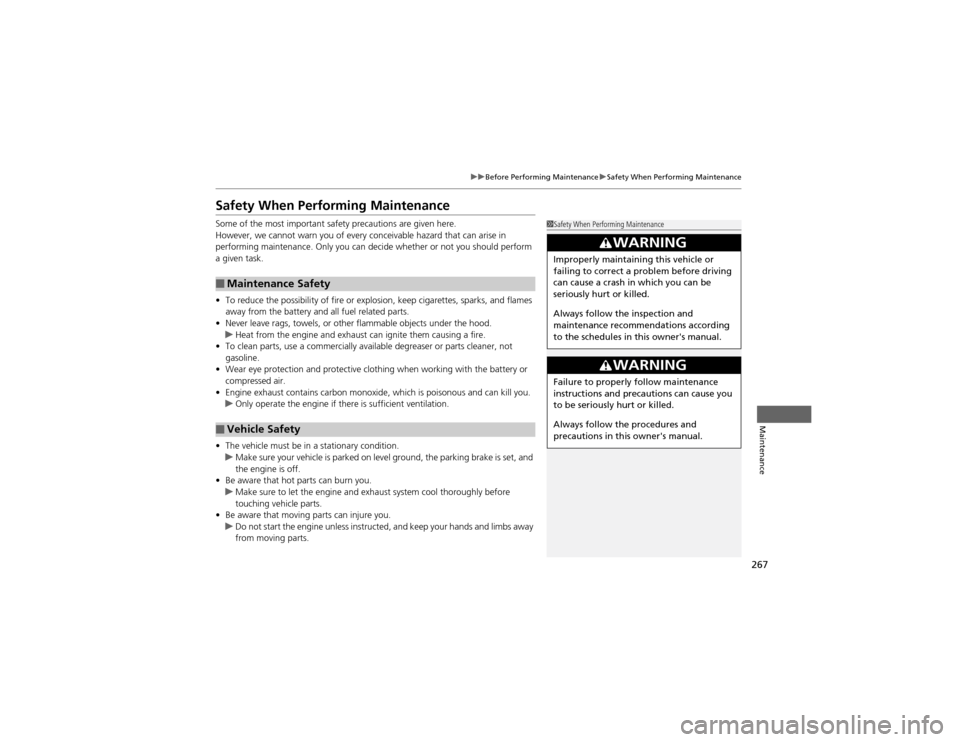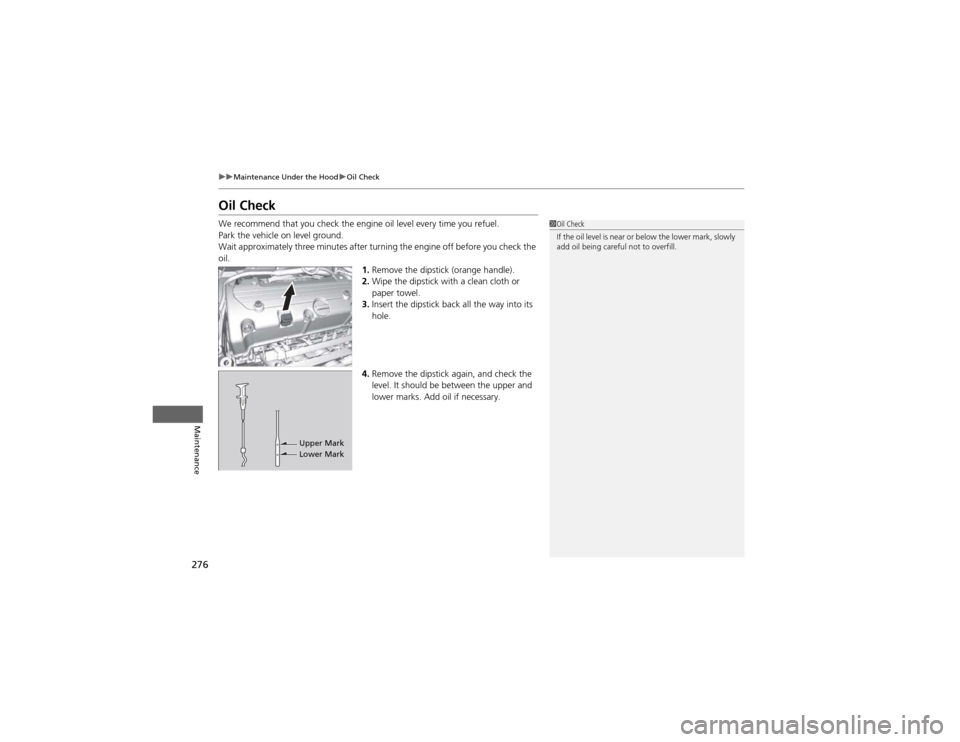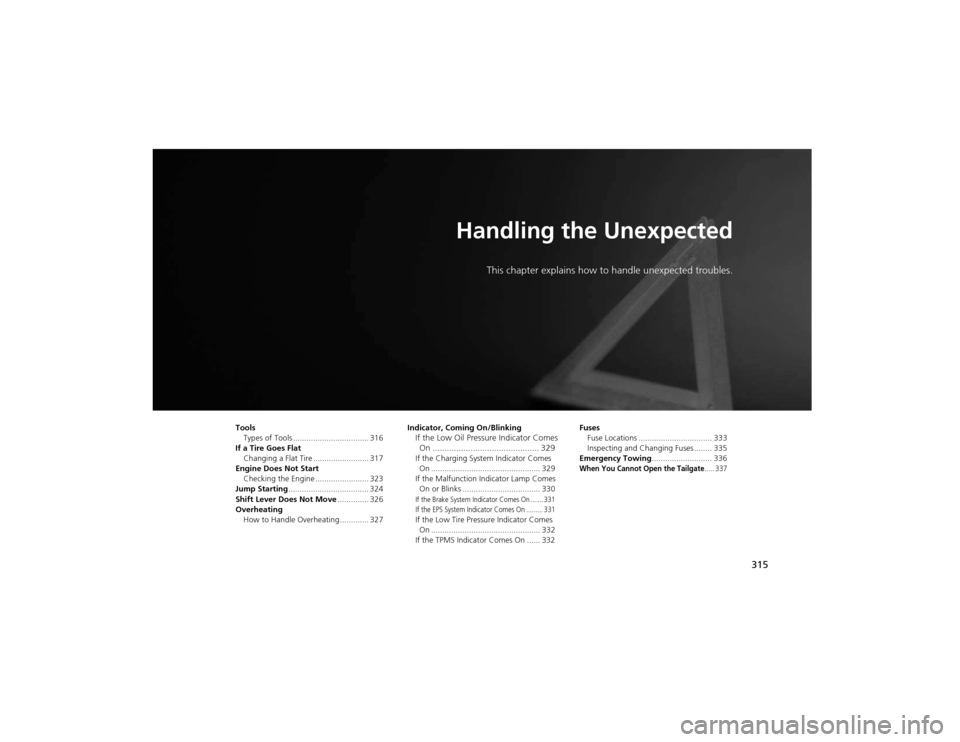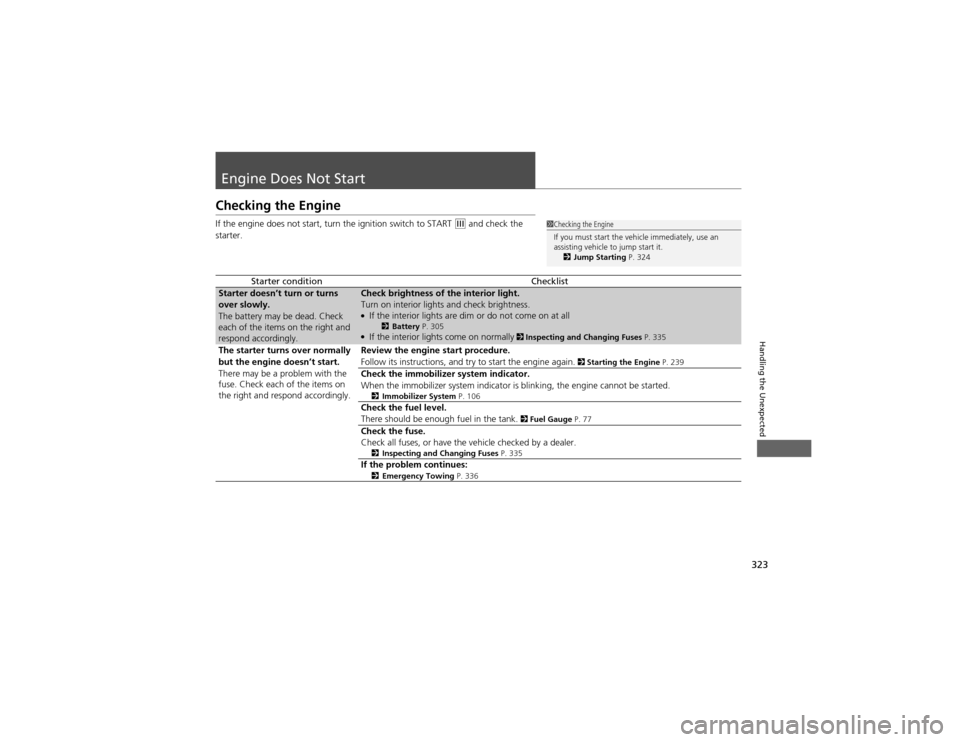tow HONDA CR-V 2012 RM1, RM3, RM4 / 4.G Owner's Manual
[x] Cancel search | Manufacturer: HONDA, Model Year: 2012, Model line: CR-V, Model: HONDA CR-V 2012 RM1, RM3, RM4 / 4.GPages: 361, PDF Size: 7.25 MB
Page 244 of 361

243
uuWhen DrivinguShifting
Continued
Driving
Shifting
Change the shift position in accordance with your driving needs. ■Shift lever positions
1Shifting
You cannot turn the ignition switch to LOCK
(0 and
remove the key unless the shift lever is in (P .
The vehicle may move forward very slightly even in
(N while the engine is cold.
Depress the brake pedal firmly and, when necessary,
apply the parking brake.Park
Used when parking or starting the
engine
Reverse
Used when reversing
Neutral
Used when idling
Drive
Used for normal driving (gears change
between 1st and 5th au tomatically)
Drive (D3)Press the
(d button while the shift lever
is in (D .
Used when: ● Going up or down hills
● Towing a trailer in hilly terrain
Second
Used to increase engine braking
(the transmission is locked in 2nd gear)
First
Used to further increase engine braking
(the transmission is locked in 1st gear)
Release Button(d
Button
Page 268 of 361

267
uuBefore Performing MaintenanceuSafety When Performing Maintenance
Maintenance
Safety When Performing Maintenance
Some of the most important safety precautions are given here.
However, we cannot warn you of every conceivable hazard that can arise in
performing maintenance. Only you can decide whether or not you should perform
a given task. • To reduce the possibility of fire or explosion, keep cigarettes, sparks, and flames
away from the battery and all fuel related parts.
• Never leave rags, towels, or other flammable objects under the hood.
uHeat from the engine and exhaust can ignite them causing a fire.
• To clean parts, use a commercially available degreaser or parts cleaner, not
gasoline.
• Wear eye protection and protective clothing when working with the battery or
compressed air.
• Engine exhaust contains carbon monoxide, which is poisonous and can kill you.
uOnly operate the engine if there is sufficient ventilation.
• The vehicle must be in a stationary condition.
uMake sure your vehicle is parked on level ground, the parking brake is set, and
the engine is off.
• Be aware that hot parts can burn you.
uMake sure to let the engine and exhaust system cool thoroughly before
touching vehicle parts.
• Be aware that moving parts can injure you.
uDo not start the engine unless instructed, and keep your hands and limbs away
from moving parts.
■Maintenance Safety
■Vehicle Safety
1Safety When Performing Maintenance
3WARNING
Improperly maintaining this vehicle or
failing to correct a problem before driving
can cause a crash in which you can be
seriously hurt or killed.
Always follow the inspection and
maintenance recommendations according
to the schedules in this owner's manual.
3WARNING
Failure to properly follow maintenance
instructions and precautions can cause you
to be seriously hurt or killed.
Always follow the procedures and
precautions in this owner's manual.
Page 275 of 361

274
uuMaintenance Under the HooduOpening the Hood
Maintenance
Opening the Hood1.Park the vehicle on a level surface, and set
the parking brake.
2. Pull the hood release handle under the
lower left corner of the dashboard.
uThe hood will pop up slightly.
3. Push up the hood latch lever in the center
of the hood to release the lock mechanism,
and open the hood.
4. Remove the support rod from the clamp
using the grip. Mount the support rod in
the hood.
When closing, remove the support rod, and
stow it in the clamp, then gently lower the
hood. Remove your hand at a height of
approximately 12 inches (30 cm) and let the
hood close.
1Opening the Hood
NOTICEDo not open the hood when the wiper arms are raised.
The hood will strike the wipers, and may damage
either the hood or the wipers.
When closing the hood, check that the hood is
securely latched.
If the hood latch lever moves stiffly, or if you can
open the hood without lifting the lever, the latch
mechanism should be cleaned and lubricated.
Hood Release Handle
Pull
Lever
Support Rod Grip
Clamp
Page 277 of 361

276
uuMaintenance Under the HooduOil Check
Maintenance
Oil Check
We recommend that you check the engine oil level every time you refuel.
Park the vehicle on level ground.
Wait approximately three minutes after turning the engine off before you check the
oil.1.Remove the dipstick (orange handle).
2. Wipe the dipstick with a clean cloth or
paper towel.
3. Insert the dipstick back all the way into its
hole.
4. Remove the dipstick again, and check the
level. It should be between the upper and
lower marks. Add oil if necessary.
1Oil Check
If the oil level is near or below the lower mark, slowly
add oil being careful not to overfill.
Upper Mark
Lower Mark
Page 286 of 361

285
Continued
Maintenance
Replacing Light Bulbs
Headlight Bulbs
When replacing, use the following bulbs.
1.Remove the coupler.
2. Remove the rubber weather seal.
3. Remove the hold-down wire, then remove
the bulb.
4. Insert a new bulb.
High/Low beam headlight:60/55W (H4/HB2)
■High/Low Beam Headlight
1Headlight Bulbs
NOTICEHalogen bulbs get very hot when lit.
Oil, perspiration, or a scratch on the glass can cause
the bulb to overheat and shatter.
The headlight aim is set by the factory, and does not
need to be adjusted. However, if you regularly carry
heavy items in the cargo area or tow a trailer, have
the aiming readjusted at a dealer or by a qualified
technician.
The H4/HB2 type is halogen bulb.
When replacing a bulb, handle it by its base, and
protect the glass from contact with your skin or hard
objects. If you touch the glass, clean it with
denatured alcohol and a clean cloth.
The exterior lights' inside lenses (headlights, brake
lamps, etc.) may fog temporarily after a vehicle wash
or while driving in the rain. This does not impact the
exterior light function.
However, if you see a large amount of water or ice
accumulated inside the lenses, have your vehicle
inspected by a dealer.
Coupler
Rubber Weather
Seal
Bulb
Hold-down Wire
Page 306 of 361

305
Maintenance
Battery
Checking the BatteryCheck the battery condition monthly. Look at
the test indicator window and check the
terminals for corrosion.
If your vehicle's battery is disconnected or goes dead: • The audio system is disabled.
2 Reactivating the audio system P. 152
• The clock resets.
2 Setting the Clock P. 96
• The navigation system *
is disabled.
2 Refer to the navigation system manual
Charging the Battery
Disconnect both battery cables to prevent damaging your vehicle's electrical system.
Always disconnect the negative (–) cable first, and reconnect it last.
1Battery
WARNING: Battery post, terminals,
and related accessories contain lead and lead compounds.
Wash your hands after handling.
The test indicator's color information is on the battery.
When you find corrosion, clean the battery terminals
by applying a baking powder and water solution.
Rinse the terminals with water. Cloth/towel dry the
battery. Coat the terminals with grease to help
prevent future corrosion.
3WARNING
The battery gives off explosive hydrogen
gas during normal operation.
A spark or flame can cause the battery to
explode with enough force to kill or
seriously hurt you.
When conducting any battery
maintenance, wear protective clothing and
a face shield, or have a skilled technician do it.
Test Indicator Window
* Not available on all models
Page 316 of 361

315
Handling the UnexpectedThis chapter explains how to h andle unexpected troubles.
Tools
Types of Tools .................................. 316
If a Tire Goes Flat Changing a Flat Tire ......................... 317
Engine Does Not Start Checking the Engine ........................ 323
Jump Starting .................................... 324
Shift Lever Does Not Move .............. 326
Overheating How to Handle Overheating ............. 327 Indicator, Coming On/Blinking
If the Low Oil Pressure Indicator Comes
On ............................................. 329
If the Charging System Indicator Comes
On ................................................. 329
If the Malfunction Indicator Lamp Comes On or Blinks ................................... 330
If the Brake System Indicator Comes On ....... 331If the EPS System Indicator Comes On ......... 331If the Low Tire Pressure Indicator Comes
On ................................................. 332
If the TPMS Indicator Comes On ...... 332 Fuses
Fuse Locations ................................. 333
Inspecting and Changing Fuses ........ 335
Emergency Towing ........................... 336
When You Cannot Open the Tailgate..... 337
Page 324 of 361

323
Handling the Unexpected
Engine Does Not Start
Checking the Engine
If the engine does not start, turn the ignition switch to START
(e and check the
starter.
Starter conditionChecklistStarter doesn’t turn or turns
over slowly.
The battery may be dead. Check
each of the items on the right and respond accordingly.Check brightness of the interior light.
Turn on interior lights and check brightness. ● If the interior lights are dim or do not come on at all
2Battery P. 305
● If the interior lights come on normally 2 Inspecting and Changing Fuses P. 335
The starter turns over normally
but the engine doesn’t start.
There may be a problem with the
fuse. Check each of the items on
the right and respond accordingly.Review the engine start procedure.
Follow its instructions, and try to start the engine again. 2
Starting the Engine P. 239
Check the immobilizer system indicator.
When the immobilizer system indicator is blinking, the engine cannot be started.
2Immobilizer System P. 106
Check the fuel level.
There should be enough fuel in the tank. 2
Fuel Gauge P. 77
Check the fuse.
Check all fuses, or have the vehicle checked by a dealer.
2Inspecting and Changing Fuses P. 335
If the problem continues:
2Emergency Towing P. 336
1Checking the Engine
If you must start the vehicle immediately, use an
assisting vehicle to jump start it.
2 Jump Starting P. 324
Page 337 of 361

336
Handling the Unexpected
Emergency Towing
Call a professional towing service if you need to tow your vehicle. ■Flat bed equipment
The operator loads your vehicle on the back of a truck.
This is the best way to transport your vehicle.
■ Wheel lift equipment
The tow truck uses two pivoting arms that go under the front tires and lift them off
the ground. The rear tires remain on the ground. This is an acceptable way to
tow your vehicle.1Emergency Towing
NOTICETrying to lift or tow your vehicle by the bumpers will
cause serious damage. The bumpers are not designed
to support the vehicle's weight.
Never tow your vehicle with just a rope or chain.
It is very dangerous, since ropes or chains may shift
from side to side or break.All models
2WD models
Page 358 of 361

357
Index
Seats.......................................................... 122
Adjusting ................................................ 122
Driver’s Seat Lumbar Support .................. 122
Front Seats.............................................. 122
Rear Seats ............................................... 129
Seat Heaters ........................................... 139
Security System ........................................ 106
Immobilizer System Indicator..................... 75
Security System Alarm Indicator ................ 75
SEL/RESET Knob .................................... 78, 81
Select Lever ........................................ 15, 243
Operation ......................................... 15, 244
Releasing ................................................ 326
Won’t Move ........................................... 326
Selecting a Child Seat ................................ 56
Selector Knob (Audio) ............................. 153
Setting the Clock ........................................ 96
Shift Lever .......................................... 15, 243
Shift Lever Position Indicator ............ 69, 244
Shifting (Transmission) ............................ 243
Shoulder Anchor ........................................ 33
Side Airbags ............................................... 44
Cutoff System ........................................... 46
Off Indicator ............................................. 46
Side Curtain Airbags .................................. 47
SMS Text Message ............................ 206, 218
Snow Tires ................................................ 304
Spare Tire ......................................... 317, 341
Spark Plugs ............................................... 340
Specifications ........................................... 340
Specified Fuel ................................... 259, 340 Speedometer
.............................................. 77
SRS Airbags (Airbags) ................................. 40
Starting the Engine .................................. 239
Does Not Start ......................................... 323
Engine Switch Buzzer .............................. 111
Jump Starting .......................................... 324
Steering Wheel ......................................... 119
Adjusting................................................. 119
Stopping .................................................... 257
Summer Tires ............................................ 304
Sunglasses Holder ..................................... 138
Supplemental Restraint System (SRS) ........ 40
Switches (Around the Steering
Wheel) ............................................. 2, 3, 111
Synchronized Mode .................................. 147
T
Tachometer ................................................. 77
Tailgate ..................................................... 104
Unable to Open ....................................... 337
Temperature Gauge ................................... 77
Temperature Sensor ................................. 148
Text Message .................................... 206, 218
Time (Setting) ............................................. 96
Tire Pressure Monitoring System (TPMS) ..................................................... 250
Indicator ............................................ 73, 332
Tires ........................................................... 296
Air Pressure ..................................... 297, 341
Checking and Maintaining....................... 296 Inspection ............................................... 296
Labeling .................................................. 297
Puncture (Flat Tire) .................................. 317
Regulations ............................................. 299
Rotation .................................................. 303
Spare Tire ........................................ 317, 341
Summer .................................................. 304
Tire Chains .............................................. 304
Wear Indicators ....................................... 301
Winter..................................................... 304
Tonneau Cover ......................................... 140
Tools .......................................................... 316
Towing a Trailer ....................................... 231
Equipment and Accessories ..................... 232
Load Limits .............................................. 231
Towing Your Vehicle ................................ 235
Behind a Motorhome .............................. 235
Emergency .............................................. 336
TPMS (Tire Pressure Monitoring
System) .................................................... 250
Indicator............................................ 73, 332
Transmission ............................................. 243
Automatic ............................................... 243
Fluid ........................................................ 282
Number................................................... 342
Shift Lever Position Indicator.............. 69, 244
Trip Meter ................................................... 79
Troubleshooting ....................................... 315
Blown Fuse...................................... 333, 334
Brake Pedal Vibrates .................................. 19
Buzzer Sounds When Opening Door.......... 20